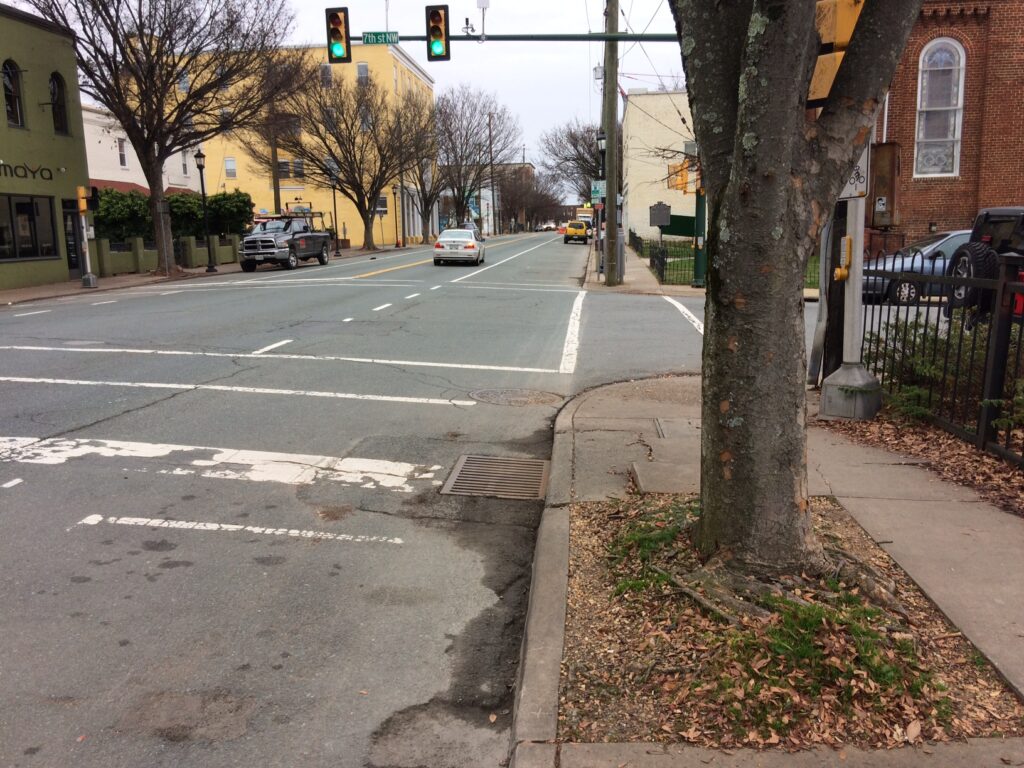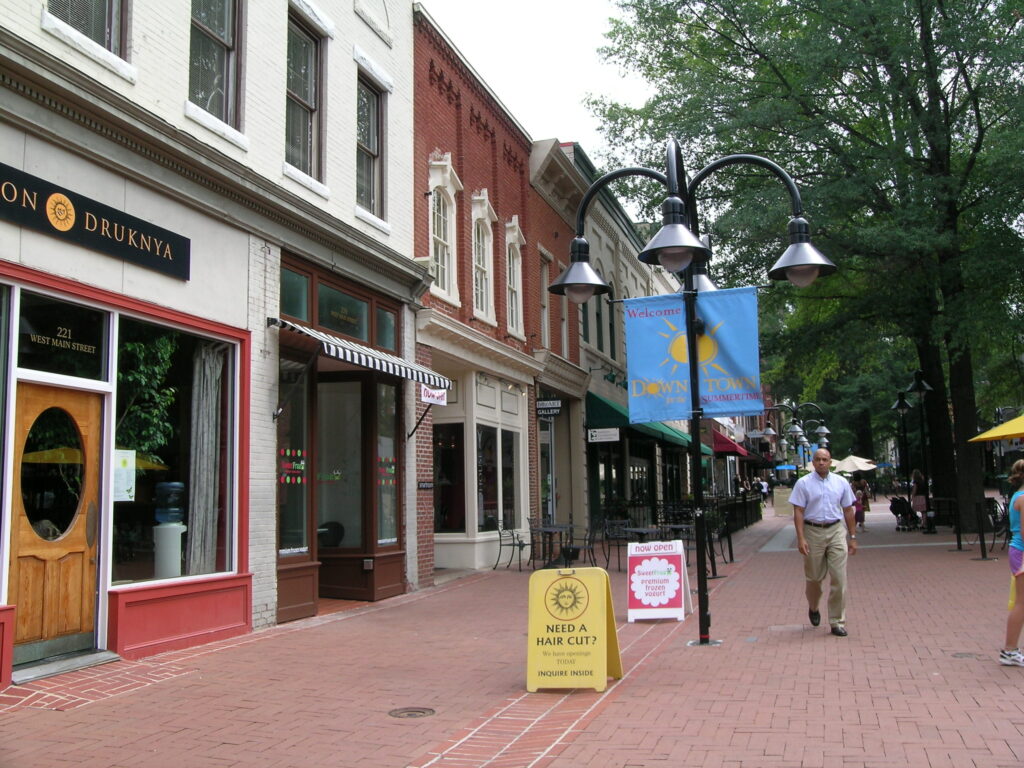
This is the first of a three-part series on how we we move, develop, and build within our cities matters to the health and well-being of our planet and our communities by architect Kathy Galvin, FAIA
How we move shapes the evolution of cities, and cities, by virtue of their diversity, compactness, and capacity to innovate, will play a critical role in solving the chronic problems amplified by the pandemic, from global climate change to social and racial inequality. To successfully address these challenges, we must transform our transportation system.
Sustainability
Current transportation practices have contributed to global warming and negative health outcomes. Before cars dominated our landscape, residential densities ranged between 17 to 34 dwelling-units per acre in multi-story buildings, on small parcels with shallow setbacks. These densities supported many activities accessible by foot within a compact city or town footprint. Densities today are one-tenth those historical norms thanks to the development of low density, single-use, single-story buildings on large lots with deep setbacks in far-flung subdivisions.[1] These have been enabled by the long distances, traversable by cars, and national street planning standards that prioritize uninterrupted car movement. Since then, sprawling development has encroached upon natural environments[2], destroyed habitats (and correlates with increased zoonotic infections like coronavirus)[3] and consumed the forests that pull carbon dioxide out of the atmosphere. The transportation sector is now a prime contributor to greenhouse gas emissions that accelerate global warming and instigate extreme weather events.[4] Human fatalities due to traffic accidents crashes have increased, as more Americans drive to work now than sixty years ago on faster, wider streets with low frequencies of intersections.[5] Together these factors have proven to be more dangerous than the walkable, tight-knit, block networks of historic cities. Deaths from heart disease and diabetes have risen as increased driving has led to less physical activity.[6] Walking diminishes the likelihood of dying from heart disease for people with diabetes, and Black Virginians die of diabetes at twice the rate of white.[7] The latter makes the lack of safe, public walking routes an equity issue. Ironically, the rise in telecommuting since the pandemic, decreased both tail pipe emissions and traffic congestion, which has convolutedly increased traffic fatalities by eight percent as fewer motorists engaged in more reckless driving on roads built for speed not pedestrians and cyclists.[8]
Today’s transportation systems are unsustainable. Streets must be completely reimagined and reengineered to be less dangerous. Narrower travel lanes, more visual constraints like street trees, clear sidewalk circulation, and more intersections with well-marked crosswalks. The walkable, small-block networks of our historic cities are ideal models for this transformation.
Equity
Inequitable transportation practices have reinforced geographic segregation by class and race, disproportionately endangered people of color, imposed the cost of car-ownership on lower income workers, and diverted investments from more affordable modes of travel like walking, bus riding or cycling. Beginning in the 1950s, car mobility was privileged by a federal urban renewal that destroyed Black urban neighborhoods to make way for large, wide, fast roads to accommodate white suburban commuters. A small city in Central Virginia, home to a world-renown university, provides a case in point.
The historic Black neighborhood of Vinegar Hill in Charlottesville, Va., once had nine, walkable blocks lined with Black-owned homes and businesses. Cleared in 1965, this area is now dominated by two superblocks of parking lots and corporate chains. Adjacent streets, like Preston Avenue, were widened to facilitate “smooth operation at fairly high speeds” for suburban commuters,[9] while West Main Street was severed from its eastern half by a widened Ridge/McIntire Road, resulting in one of the most hazardous intersections in the city.[10] Whereas East Main Street became a commercially successful pedestrian mall, West Main Street’s 19th century storefronts were replaced by a commercial strip dominated by auto merchants and mechanics. Over time, its narrow sidewalks became cluttered with utility equipment, heaving surface roots and driveways, rendering walking and accessibility hazardous. Pedestrian-oriented improvements recommended for Preston Avenue and West Main Street in 2000, however, were not implemented ahead of 2003 zoning changes that spurred higher density, private development, with dire consequences.[11]
By 2016, both streets ranked among the city’s most dangerous corridors. They are also flanked by two lower income census tracts with high percentages of Black residents, reflecting a troubling national correlation between race, geography, and public investment. Nationwide, between 2010–2019, 82% more Black pedestrians were killed in car crashes than whites, and pedestrian fatality rates in the lowest income neighborhoods were nearly three times higher than the wealthiest.[12] Unlike their white counterparts, Black and brown neighborhoods often lack streets designed for slow car traffic, continuous sidewalks, marked crosswalks and street trees, making these neighborhoods hotter in summer with lower air quality year-round — conditions that aggravate respiratory ailments like asthma that causes three times the deaths among Black people than white. When combined with poverty, racism, poor health care and food insecurity, these social determinants to health help explain why life expectancies can be as much as 5–20 years shorter in predominantly Black neighborhoods compared to white.[13] The few city neighborhoods that escaped urban renewal and retained their pedestrian-oriented street networks and architectural character saw their land values increase beginning in the 1980s as demand for walkable, authentic, urban places rose among America’s wealthier, often white, professional classes, spurring revitalization and gentrification in cities nationwide.[14] The inherent injustice within the distribution of private investment in the market further drives national inequities between race, geography and public investment, as summed up in Spike Lee’s question, “Why does it take an influx of white New Yorkers in the south Bronx, in Harlem, in Bed Stuy, in Crown Heights for the facilities to get better?”[15]
Adversity to Opportunity
Unchecked gentrification pushes lower-income residents into lower-cost neighborhoods and overcrowded conditions (making them more susceptible to coronavirus) and outlying suburbs with cheaper land costs in pursuit of more affordable housing. Those who leave incur the cost of car ownership.[16] Those who stay become dependent on public transit systems, now subject to service cuts caused by the rise in telecommuting in the pandemic’s wake.[17] These dynamics have contributed to recent spikes in poverty and food insecurity and help explain disparities in coronavirus mortality rates between demographic groups.[26] Capital investment in inclusive infrastructure, including transit, and dedicated affordable housing units as a check against gentrification are not mutually exclusive. Both make a more sustainable and equitable city. Anti-displacement measures should also include zoning reform to safeguard a city’s uniqueness while expanding affordable housing city-wide and programs that relieve tax burdens for low- income homeowners, provide rental and childcare assistance, and grow wealth within the Black community to redress urban renewal’s injustices.[18]
Neighborhoods hallmarked by physical and social conditions that promote health and longevity should not remain the sole domain of privileged, predominately white residents with means, just as affordable housing should no longer be sited within environmentally compromised areas of cheap land absent the infrastructure needed to promote human health.[19] Instead, affordable housing must be developed in partnership with the communities it serves using the healthy neighborhoods construct to generate prosperity and well-being for all residents.[20] If affordable housing is solely reduced to matters of density and relieving housing market pressures, then we will consign children born into poverty today to an unhealthy future devoid of fresh food, public parks, and tree-lined streets safe for walking, bus riding and cycling.
In the face of mounting adversity, all levels of government now appear ready to transform our transportation system while addressing climate change and inequality. Virginia has expanded funding for rail and transit and made capital investments in local multi-modal initiatives like Charlottesville’s West Main Street Improvement Project. adopted in 2016[21] Virginia localities must plan now for transit-oriented development (TOD) such as Charlottesville’s Hydraulic Road small area plan along US Route 29, which repurposes an aging retail center surrounded by parking lots into a neighborhood with walkable, interconnected streets lined with local businesses, public spaces, and affordable housing options.[22] Proposed national “complete streets” legislation (similar to Charlottesville’s “Streets that Work” Plan,) seeks to hasten adoption of multi-modal street standards nationwide. The new Environmental Protection Agency (EPA) Administrator, Michael Regan, has made transportation “important to our greenhouse gas goals.”[23] President Biden’s American Rescue Plan includes funding for transit and school modernization,[24] and his next major bill will focus on rebuilding our failing infrastructure, address climate change and grow local jobs. If local projects need to be “shovel ready” to receive these federal funds, then Charlottesville’s West Main Street Improvement Project is ready. As Transportation Secretary Pete Buttigieg said, repeated calls to rebuild our infrastructure “will no longer be a kind of Groundhog’s Day promise” but actually deliver “generational investments.”[25] That promise however, depends upon local elected officials seizing these opportunities to turn plans into action and tangibly transform the way we move and shape our cities for generations to come. Otherwise, it will always be Groundhog’s Day, even in progressive cities like Charlottesville.
Footnotes
[1] Pedestrian and Transit-Friendly Design: A Primer for Smart Growth by Reid Ewing of the Smart Growth Network, for the American Planning Association, page 2
[2] Carbon Positive: Density, COVID and the Future of Cities,” Edward Mazria, FAIA, for Architect Magazine, September 2020,
[3] Centers for Disease Control (CDC) website, 8 Zoonotic Diseases Shared Between Animals and People of Most Concern in the U.S.
[4] “Warming Trend is Directly Related to Human Emissions of GHG” by Laura Tenebaum for Forbes, March 5, 2020
[5] “Car crash deaths since 2000 eclipse toll of World Wars” by Ashley Halsey III, Washington Post, July 22, 2019 and “The Effect of Street Network Design on Walking and Biking,” by Garrick and Marshall, 2010, https://protect-us.mimecast.com/s/chMpCR6M8kfz8gZSNmUPm?domain=old.sacog.org
[6] Harvard School of Public Health, Obesity Prevention, State of Obesity Report by the Robert Wood Johnson Foundation
[7] Vigor, by UVA Health, Spring 2021, page 34, from Harvard Health Publishing and “MAPPS2Health Report,” 2016, page 166, https://www.vdh.virginia.gov/content/uploads/sites/91/2016/07/MAPP2HealthFinalSmall.pdf
[8] “Traffic congestion vanished and more people died on the roads,” by Chris McCahill for State Smart Transportation Initiative, March 16, 2021
[9] “Vinegar Hill: A Brief Urban History” by the University of Virginia, School of Architecture, under the direction of Professor Ken Schwartz, History of Vinegar Hill (virginia.edu) and “Torti Gallas Corridor Study,” 2000, pages 82-88 and 76-81
[10] Streets that Work (STW) Plan (Chapter 1 and 5)), 2016, https://www.charlottesville.gov/DocumentCenter/View/482/2016-Streets-That-Work-Plan-PDF
[11] “Torti Gallas Corridor Study”, 2000 pages 82-88 and 76-81
[12] Dangerous by Design 2021 Report, by Smart Growth America and National Complete Streets Coalition
[13] “How our communities are planned, designed and built can have a major influence on our health,” Robert Woods Johnson Foundation on the Built Environment and Health and “Short Distance to Large Gaps in Health map of Richmond, VA,” Virginia Commonwealth University (VCU) Center on Society and Health “Mapping Life Expectancy” project https://societyhealth.vcu.edu/media/society-health/pdf/LE-Map-Richmond.jpg.
[14] “The Pandemic Disproved Urban Progressives’ Theory About Gentrification, The “gentrification-industrial complex” isn’t who anti-growth progressives think it is. JANUARY 2, 2021 by Jacob Anbinder, The Anti-growth Alliance That Fueled Urban Gentrification – The Atlantic
[15] “Five myths about gentrification” by Lance Freeman, Washington Post, June 3, 2016
[16] AAA’s annual Your Driving Costs study, 2019
[17] “A Post-Pandemic Reality Check for Transit Boosters” by Laura Bliss for CityLab, May 6, 2020
[18] Charlottesville Draft Affordable Housing Strategy of 2021, pages 77-81, Charlottesville Affordable Housing Plan – Final – Web.pdf – Google Drive, Restrictive zoning is impeding DC’s goal to build more housing, (Jenny Schuetz, Brookings Institute Fellow – Metropolitan Policy Program, Future of the Middle Class Initiative, Tuesday, October 8, 2019)
[19] Charlottesville Draft Affordable Housing Strategy of 2021, pages 77-81, Charlottesville Affordable Housing Plan – Final – Web.pdf – Google Drive, Restrictive zoning is impeding DC’s goal to build more housing, (Jenny Schuetz, Brookings Institute Fellow – Metropolitan Policy Program, Future of the Middle Class Initiative, Tuesday, October 8, 2019)
[20] “The Ingredients of Equitable Development Planning,” by Alexander von Hoffman, Joint Center for Housing Studies with Harvard Graduate School of Design and the Kennedy School, 2019
[21] “Virginia General Assembly approves higher gas tax, speed cameras and cellphone ban,” by Luz Lazo, March 8, 2020
[22] “Governor Northam Signs 16 Bills into Law: Newly-approved measures include pro-transit planning,” Press Release from Governor Northam’s Office, February 25, 2020
[23] “Science is back, says EPA’s new head,” by Grady Dennis and Dino Grandoni for the Washington Post, March 16, 2021
[24] “$1.9T COVID-19 relief package includes billions for capital projects,” by Kim Slowey for ConstructionDive, March 11, 2021
[25] “Biden team readies wider economic package after virus relief,” Kevin Freking, Hope Yen and Josh Boak, Associated Press, Feb. 28, 2021
[26] “Children’s food insecurity increasing during COVID-19 pandemic,” by Joseph Allen, Sara Bleich, Jessica Cohen, Benjamin Sommers of the Harvard Chan School of Public Health, for USA Today, October 28, 2020, https://www.hsph.harvard.edu/news/hsph-in-the-news/childrens-food-insecurity-increasing-during-covid-19-pandemic/, and “Feeding America,” 2017 and CDC website on “COVID-19 Racial and Ethnic Health Disparities,” December 10, 2020, https://www.cdc.gov/coronavirus/2019-ncov/community/health-equity/racial-ethnic-disparities/disparities-deaths.html.


